LOOV ransomware becomes the first STOP/DJVU variant of 2022
Contents
LOOV ransomware is a malicious computer virus variant that belongs to the dangerous STOP/DJVU ransomware family. The ransomware is known to function by compromising all files contained in any computer through encryption and also appending them with .loov extension. E.g., a file that was formerly saved as 1.jpg automatically becomes 1.jpg.loov and the same process is repeated continuously. While the cyber-attack is still going on, a ransom note known as _readme.txt will be released in all folders. These _readme.txt ransom notes contain a direct message from the cybercriminals with instructions on how the victim should reach out to them and pay certain amount of money as ransom in exchange for a LOOV decryption tool.
In explaining further, those behind the cyber-attack will emphasize that the entire database of the computer has been encrypted, including potentially important documents, data, pictures etc. and based on that, the only way they could hope to get back the lost data is by paying a particular amount of money as ransom in order to be given a decryption tool. To facilitate communication between them, two emails addresses namely: manager@mailtemp.ch and helpsupportmanager@airmail.cc will also be made available to the victim.
Furthermore, they will notify the victim about the various prices and conditions of payment attached. For instance, if the victim can pay within 72 hours or three days of being notified, he will be entitled to a 50% discount, which means instead of paying $980 as decryption cost, they will now have to $490. But once the grace period elapses, only the full amount will be acceptable.
However, if the victim shows any willingness of paying the ransom fee, they will also inform him that payment can only be done by purchasing the cryptocurrency equivalence of the ransom fee and transferring same to the wallet address of their choice. They always make use of such channel basically to ensure their identity is never revealed and avoid possible arrest and prosecution by law enforcement agents. In order to prove they have the capacity to decrypt encrypted files, they may request for excerpts to be used for test decryption.

However, our in-house experts strongly advise that victims of ransomware SHOULD NOT PAY RANSOM and it’s interesting to note that the same policy is supported by the FBI. It should be noted that paying the ransom does not guarantee that encrypted files will be recovered and moreover, paying such huge sums of money to cybercriminals can only empower them financially to increase their resources and victimize more computer users, which turns it into a vicious circle.
If that’s not bad enough, also consider that such decryption tools can release information-stealing Trojans in the likes of AZORULT or VIDAR on the already compromised computer for the purposes of stealing personal details such as software login credentials, cryptocurrency wallets, browser saved passwords and banking details among others. Once such sensitive and important data gets into the wrong hands, it can lead to further blackmail and extortions.
For those that are already infected with such STOP/DJVU variant, there is need to remove LOOV ransomware virus from your computer as soon as you can. The best way to get it done is by making use of a reliable antivirus while your computer is set up in Safe Mode with Networking. You can make use of any antivirus but always ensure that such antivirus is capable of doing an effective job of it. If you do not know of any antivirus you can trust, always remember that INTEGO Antivirus antivirus is exceptionally powerful and trustworthy.
In addition to that, you can also make use of RESTORO to repair any damaged file on Windows OS files.
Ransomware Summary
| Name | LOOV Ransomware Virus |
| Type | Ransomware; Crypto-malware; Virtual Extortion Virus |
| Family | STOP/DJVU |
| Encryption type | RSA 2048 + Salsa20 |
| Previous versions | KAAA, BGJS, BGZQ (find full list here) |
| Version | 368th |
| Extension | .loov |
| Cybercriminal emails | manager@mailtemp.ch, helprestoremanager@airmail.cc |
| Additional malware dropped | Azorult or Vidar Trojan |
| Damage | The ransomware attacks files on victim’s PC system and encrypts them, using .loov file marker which it appends to the original file name. The virus leaves _readme.txt ransom notes in every folder it affects. This ransomware is known to drop information-stealing Trojans on the system. The ransomware deletes Volume Shadow Copies to prevent access to existing System Restore Points. Some versions may also edit Windows HOSTS file to block access to a specific cybersecurity-related domains. |
| Ransom note | _readme.txt |
| Ransom demand | $490-$980 in Bitcoin |
| Distribution | Victims often download this ransomware along illegal torrent downloads, cracked software, activators, key generators or tools like KMSPico. |
| Known software cracks to contain this malware | Corel Draw, Tenorshare 4ukey, Adobe Photoshop, Cubase, Adobe Illustrator, Internet Download Manager, Tally, League of Legends. |
| Detection names | Trojan:Win32/Sabsik.FL.B!ml (Microsoft), Trojan.GenericKDZ.82051 (B) (Emsisoft), UDS:Trojan.Win32.Generic (Kaspersky), Gen:Variant.Babar.30049 (BitDefender), Trojan.Agent.UKED (Malwarebytes), ML.Attribute.HighConfidence (Symantec) see all detection name variations on VirusTotal |
| Removal | Remove ransomware and related malware from your PC using professional software of your choice. We highly recommend using INTEGO Antivirus. To repair virus damage on Windows OS files, consider scanning with RESTORO. |
REPAIR VIRUS DAMAGE
Scan your system for FREE to detect security, hardware and stability issues. You can use the scan results and try to remove threats manually, or you can choose to get the full version of software to fix detected issues and repair virus damage to Windows OS system files automatically. Includes Avira spyware/malware detection & removal engine.
Ransomware Distribution Techniques Used By Cybercriminals
The most common way of getting infected with such STOP/DJVU ransomware variants including LOOV virus is by downloading malicious torrents. The cybercriminals often lace pirated software copies with virus and Trojans, therefore opening fake software contents like key generator or “crack” can result in severe malware infection. In recent times, a good number of those that have fallen victim to ransomware attacks reported about certain software contents cybercriminals often make use of in distributing ransomware. These pirated license activation tools and deceptive cracks are eventually uploaded to diverse online torrent libraries:
- Cubase;
- Adobe Photoshop;
- Fifa 20;
- Tenorshare 4ukey;
- Internet Download Manager;
- AutoCad;
- Opera browser;
- Corel Draw;
- VMware Workstation;
- Adobe Illustrator;
- League of Legends;
- KMSPico (illegal Windows activation tool).
Based on the explanations above, visiting or trying to make use of software contents gotten from online torrents is highly discouraged. Such dangerous activities can only put your computer at risk of being infected with loads of malware. Also, when you download such pirated software contents, you’re involving yourself in copyright infringement which could lead to prosecution. On the contrary, when you source your software needs legitimately from the official pages of the original developers or their endorsed partners, you’re helping the industry to grow. Whatever price tag is attached to it is definitely negligible compared to the outrageous ransom fees cybercriminals would demand from their victims, and also, you won’t be at risk of losing your sensitive/vital personal data.
Aside online torrents libraries, cybercriminals also rely on malicious email attachments in distributing ransomware. They often compose “real-looking” and believable messages that would be attached to documents created on PDF, XLS or DOCX. They usually make use of these particular platforms because they enable macro functions or even JavaScript which makes it possible for external payload to be attached and exported to any computer.
They try as much as possible to camouflage their real identity, thus making it extremely difficult for unsuspecting victims to avoid the attack. They often pretend to be colleagues or even front as legitimate popular brands like Amazon, UPS or FedEx and consequently, will attach files with compelling headings such as Tracking Details, Invoice or Order Summary etc. Also, the cybercriminals sometimes make use of spoofing techniques to hide the actual sender’s email address. Nevertheless, in such situations, it is best to be cautious. If there is no need for such emails then you may as well abstain from opening it.
Be that as it may, victims of STOP/DJVU ransomware shouldn’t be desperate and start visiting dubious websites that claim to offer decryption services because such solutions scarcely exist at the moment. Trying to make use of such websites or the tools they offer may lead to more problems. Always remember that cybercriminals sometimes spread other versions of ransomware like ZORAB in the guise of fake STOP/DJVU decryptors. When you download such tools, it can lead to double encryption of your files.
More Information You Need To Know About the Virus
This section explains in full details about the technical aspect of what happens during a LOOV ransomware attack. So, if you’re wondering about the extent to which your computer was compromised due to virus infection, then this part will come handy. Firstly, the malware is known to set up build.exe or build2.exe executables which would be followed by winupdate.exe (which displays fake Windows screen). The virus then connects to https[:]//api.2ip.ua/geo.json and saves the result in geo.json file. The malware then proceeds to gathering every relevant information about the computer including its geolocation, longitude and latitude, time zone, zip code and related information, and would send the information to its central server. Here are some examples of geo.json file shown below.

Additionally, the virus gathers data about the compromised computer’s hardware and software details as well as the list of active processes.

Afterward, the malware will compare the extracted country code against a list containing encryption exempted countries, which include; Russian Federation, Uzbekistan Syria, Armenia, Tajikistan, Ukraine, Kazachstan, Kyrgyzstan, and Belarus. If the malware determines that the country code is positive with any of the aforementioned countries, it will abruptly stop any further attempts at encryption, but if otherwise, it will move to the next step by collecting an online encryption key from their server and combines it with the victim’s ID before saving them to bowsakkdestx.txt file and also to PersonalID.txt file. A good example of this file is shown below.

If for any reason, it couldn’t extract an online encryption ID, it will resort to the use of an offline one. The difference between the online and offline keys is that online keys are individually unique while offline keys are uniform. You can detect if an offline key was used if it has t1 characters appearing at the end of the personal ID. The implication is that offline keys have a higher chance of .loov files being decrypted unlike online keys. See below for more information about this.
The ransomware then commences full data encryption by scanning its entire folders and encrypting them with Salsa20 before locking them with RSA-2048 encryption key.

Shown in the image below is a screenshot of _readme.txt ransom note dropped in every folder.

Then the malware will delete Volume Shadow Copies using Command Prompt task as shown below:
vssadmin.exe Delete Shadows /All /Quiet
At last, the virus will add a list of domains to the Windows HOSTS file and tags them to the localhost IP. This move prevents the victim from getting any possible help online and DNS_PROBE_FINISHED_NXDOMAIN error may appear any time to try to open any of the blacklisted websites.
Remove LOOV Ransomware Virus and Recover Your Files
The most important action to take as a victim of ransomware attack is to report to local authorities responsible for handling such issues and also to remove LOOV ransomware virus immediately. You can follow the directions in the guide below on how to run your computer in Safe Mode with Networking. This option will enable your antivirus to function effectively in ensuring that the malware is completely removed.
The following steps are highly recommended by our team, following the removal of LOOV ransomware virus:
- Get in touch with relevant law enforcement agencies and inform them about the situation;
- Make use of any available backup device to restore your files;
- Learn possible ways to decrypt files encrypted by certain STOP/DJVU variants;
- Immediately replace all passwords that are directly or remotely connected to the compromised computer.
In conclusion, remember that the best course of action is to remain proactive by avoiding online torrents libraries or the opening of malicious email attachments.
OUR GEEKS RECOMMEND
Our team recommends removing malware using a professional antivirus software.
REMOVE THREATS WITH ROBUST ANTIVIRUS

Get INTEGO ANTIVIRUS for Windows to remove ransomware, Trojans, adware and other spyware and malware variants and protect your PC and network drives 24/7. This VB100-certified security software uses state-of-art technology to provide protection against ransomware, Zero-Day attacks and advanced threats, Intego Web Shield blocks dangerous websites, phishing attacks, malicious downloads and installation of potentially unwanted programs.
Use INTEGO Antivirus to remove detected threats from your computer.
GeeksAdvice.com editors select recommended products based on their effectiveness. We may earn a commission from affiliate links, at no additional cost to you. Learn more.
LOOV Ransomware Virus Removal Guidelines
Method 1. Enter Safe Mode with Networking
Step 1. Start Windows in Safe Mode with Networking
Before you try to remove LOOV Ransomware Virus virus, you must start your computer in Safe Mode with Networking. Below, we provide the easiest ways to boot PC in the said mode, but you can find additional ones in this in-depth tutorial on our website – How to Start Windows in Safe Mode. Also, if you prefer a video version of the tutorial, check our guide How to Start Windows in Safe Mode on Youtube.
Instructions for Windows XP/Vista/7 users
- First of all, turn off your PC. Then press the Power button to start it again and instantly start pressing F8 button on your keyboard repeatedly in 1-second intervals. This launches the Advanced Boot Options menu.
- Use arrow keys on the keyboard to navigate down to Safe Mode with Networking option and press Enter.

Instructions for Windows 8/8.1/10/11 users
- Open Windows Start menu, then press down the Power button. On your keyboard, press down and hold the Shift key, and then select Restart option.

- This will take you to Windows Troubleshoot screen. Choose Troubleshoot > Advanced Options > Startup Settings > Restart. Tip: If you can't find Startup Settings, click See more recovery options.

- In Startup Settings, press the right key between F1-F9 to enter Safe Mode with Networking. In this case, it is the F5 key.

Step 2. Remove files associated with the virus
Now, you can search for and remove LOOV Ransomware Virus files. It is very hard to identify files and registry keys that belong to the ransomware virus, Besides, malware creators tend to rename and change them repeatedly. Therefore, the easiest way to uninstall such type of a computer virus is to use a reliable security program such as INTEGO Antivirus. For virus damage repair, consider using RESTORO.
Special Offer
Compatibility: Microsoft Windows
See Full Review
RESTORO is a unique PC Repair Tool which comes with an in-built Avira scan engine to detect and remove spyware/malware threats and uses a patented technology to repair virus damage. The software can repair damaged, missing or malfunctioning Windows OS files, corrupted DLLs, and more. The free version offers a scan that detects issues. To fix them, license key for the full software version must be purchased.
Method 2. Use System Restore
In order to use System Restore, you must have a system restore point, created either manually or automatically.
Step 1. Boot Windows in Safe Mode with Command Prompt
Instructions for Windows XP/Vista/7 users
- Shut down your PC. Start it again by pressing the Power button and instantly start pressing F8 button on your keyboard repeatedly in 1-second intervals. You will see Advanced Boot Options menu.
- Using arrow keys on the keyboard, navigate down to Safe Mode with Command Prompt option and press Enter.

Instructions for Windows 8/8.1/10/11 users
- Launch Windows Start menu, then click the Power button. On your keyboard, press down and hold the Shift key, and then choose Restart option with the mouse cursor.

- This will take you to Windows Troubleshoot screen. Choose Troubleshoot > Advanced Options > Startup Settings > Restart. Tip: If you can't find Startup Settings, click See more recovery options.

- In Startup Settings, press the right key between F1-F9 to enter Safe Mode with Command Prompt. In this case, press F6 key.

Step 2. Start System Restore process
- Wait until system loads and command prompt shows up.
- Type cd restore and press Enter, then type rstrui.exe and press Enter. Or you can just type %systemroot%system32restorerstrui.exe in command prompt and hit Enter.

- This launches System Restore window. Click Next and then choose a System Restore point created in the past. Choose one that was created before ransomware infection.

- Click Yes to begin the system restoration process.
After restoring the system, we recommend scanning the system with antivirus or anti-malware software. In most cases, there won't be any malware remains, but it never hurts to double-check. In addition, we highly recommend checking ransomware prevention guidelines provided by our experts in order to protect your PC against similar viruses in the future.
Alternative software recommendations
Malwarebytes Anti-Malware
Removing spyware and malware is one step towards cybersecurity. To protect yourself against ever-evolving threats, we strongly recommend purchasing a Premium version of Malwarebytes Anti-Malware, which provides security based on artificial intelligence and machine learning. Includes ransomware protection. See pricing options and protect yourself now.

System Mechanic Ultimate Defense
If you're looking for an all-in-one system maintenance suite that has 7 core components providing powerful real-time protection, on-demand malware removal, system optimization, data recovery, password manager, online privacy protection and secure driver wiping technology. Therefore, due to its wide-range of capabilities, System Mechanic Ultimate Defense deserves Geek's Advice approval. Get it now for 50% off. You may also be interested in its full review.

Disclaimer. This site includes affiliate links. We may earn a small commission by recommending certain products, at no additional cost for you. We only choose quality software and services to recommend.
Decrypt LOOV files
Fix and open large LOOV files easily:
It is reported that STOP/DJVU ransomware versions encrypt only the beginning 150 KB of each file to ensure that the virus manages to affect all files on the system. In some cases, the malicious program might skip some files at all. That said, we recommend testing this method on several big (>1GB) files first.
- Create a copy of encrypted file to a separate folder using Copy > Paste commands.
- Now, right-click the created copy and choose Rename. Select the LOOV extension and delete it. Press Enter to save changes.
- In the prompt asking whether you want to make the changes as file might become unusable, click OK.
- Try opening the file.
STOP/DJVU decryption tool usage guide
STOP/DJVU ransomware versions are grouped into old and new variants. LOOV Ransomware Virus is considered the new STOP/DJVU variant, just like KAAA, BGJS, BGZQ (find full list here). This means full data decryption is now possible only if you have been affected by offline encryption key. To decrypt your files, you will have to download Emsisoft Decryptor for STOP DJVU, a tool created and maintained by a genius security researcher Michael Gillespie.
Note! Please do not spam the security researcher with questions whether he can recover your files encrypted with online key - it is not possible.
In order to test the tool and see if it can decrypt LOOV files, follow the given tutorial.
- Download the decryption tool from Emsisoft.
- Click the little arrow next to your download and choose Show in Folder.
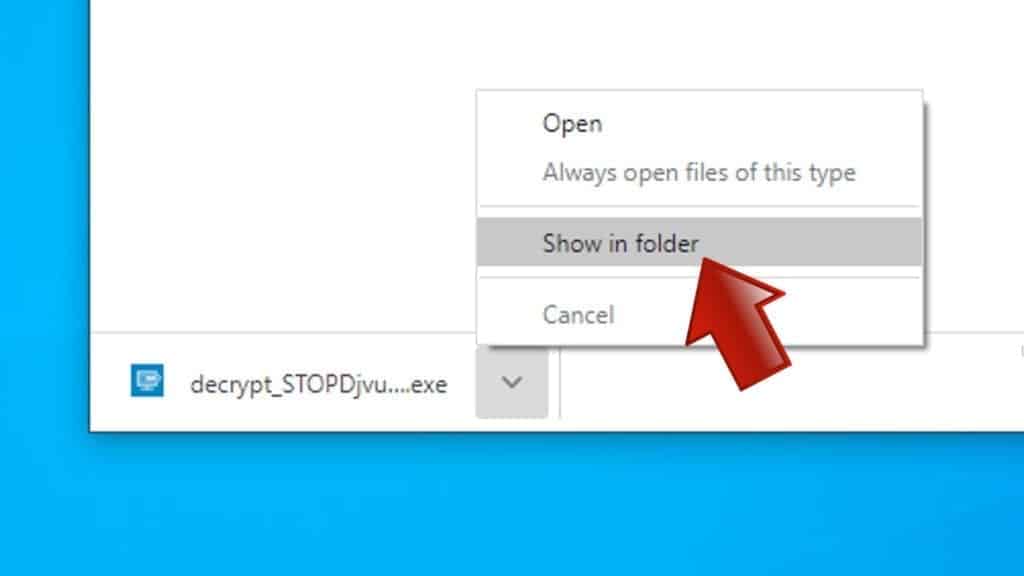
- Now, right-click the file and choose Run as Administrator. If asked, enter administrator's password.
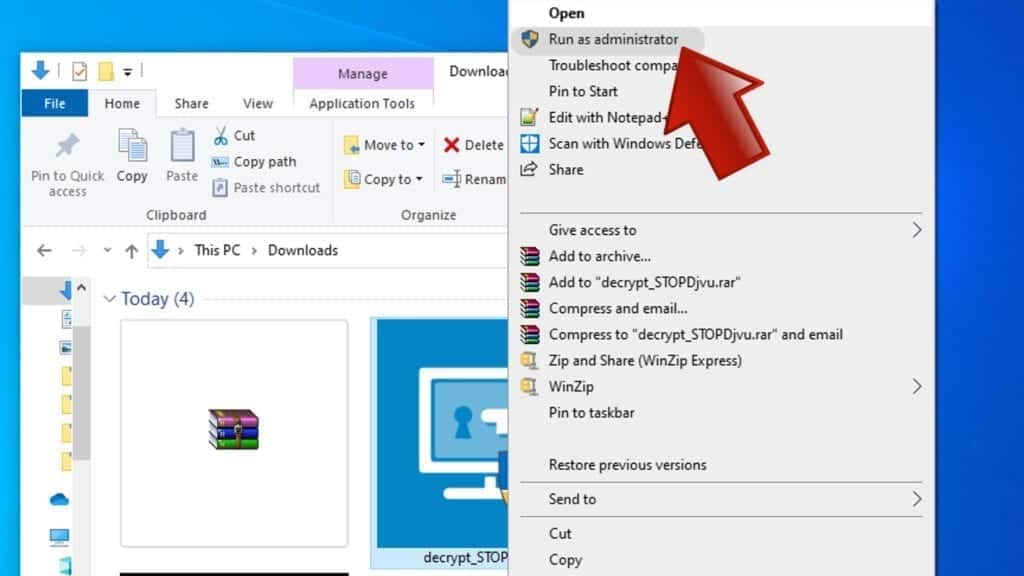
- In UAC window, click Yes.
- Click Yes to agree to software terms in both windows.
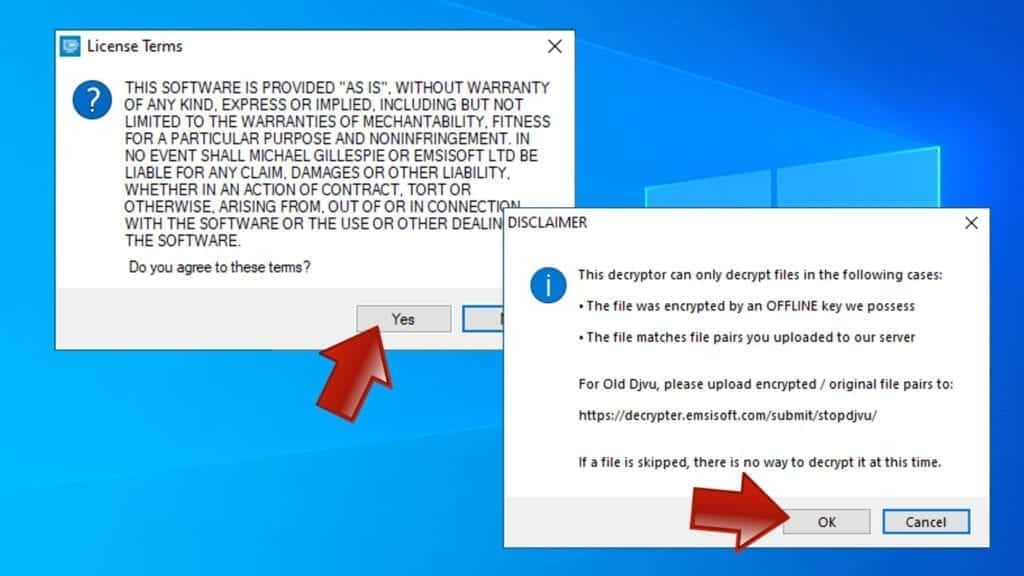
- The tool will automatically include C:// disk as a location to decrypt. The file recovery tool will prepopulate the locations to scan, including connected data storage drives or network drives. Click Add folder if you wish to add additional locations.
In Options tab, you can choose to keep encrypted file copies. We recommend leaving this option selected, especially if you do not know if the decryption tool will work.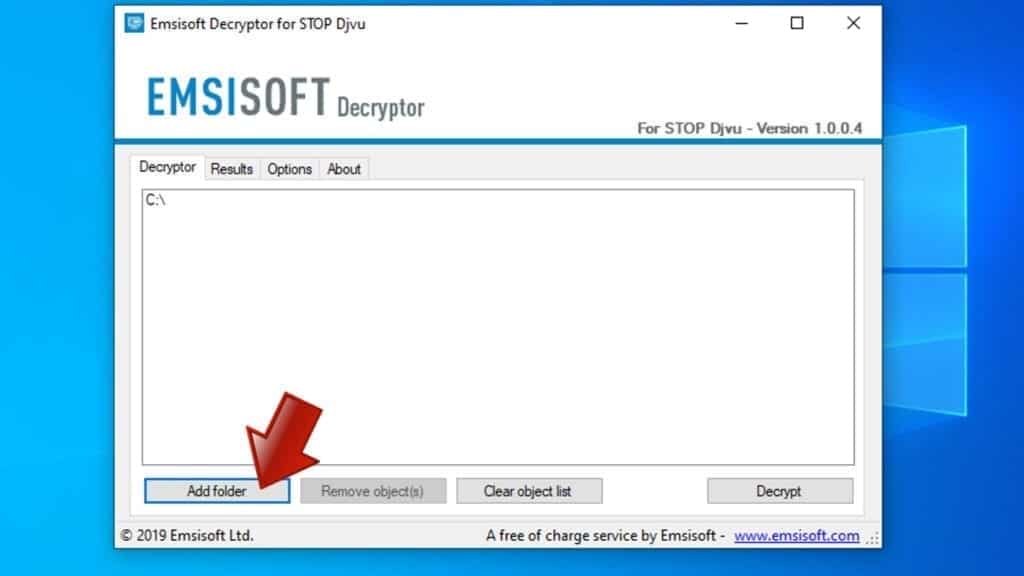
- Click Decrypt to start restoring LOOV files. You will see the progress in the Results tab. Here, you can see messages from the tool, such as whether the decryption procedure is successful, or you need to wait for an update.
You might also be informed that online key was used to encrypt your files. In such case, the decryption tool won't work for you, and the only way to recover your files is to use a data backup.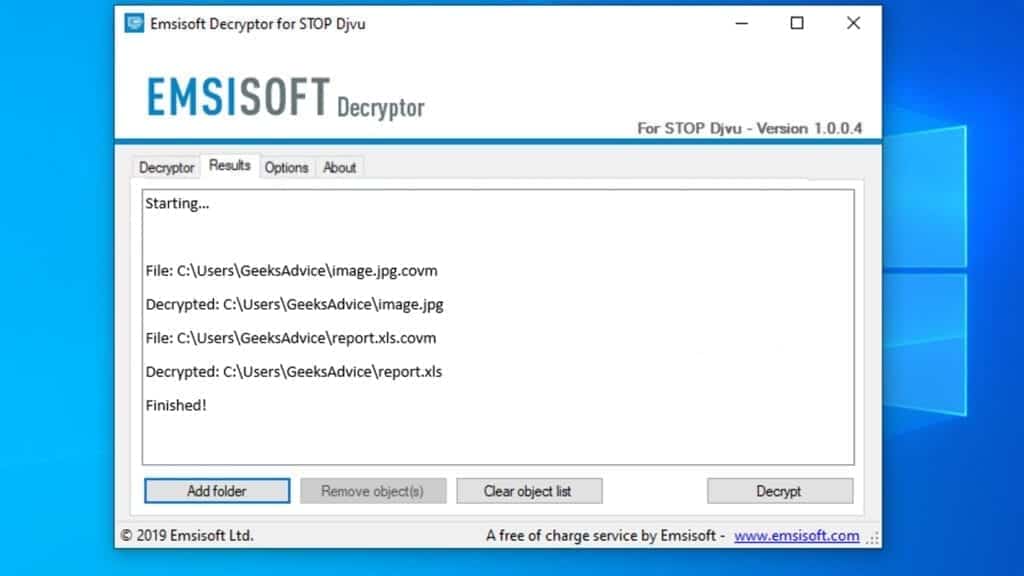
Meanings of decryptor's messages
The LOOV decryption tool might display several different messages after failed attempt to restore your files. You might receive one of the following messages:
Error: Unable to decrypt file with ID: [example ID]
This message typically means that there is no corresponding decryption key in the decryptor's database.
No key for New Variant online ID: [example ID]
Notice: this ID appears to be an online ID, decryption is impossible
This message informs that your files were encrypted with online key, meaning no one else has the same encryption/decryption key pair, therefore data recovery without paying the criminals is impossible.
Result: No key for new variant offline ID: [example ID]
This ID appears to be an offline ID. Decryption may be possible in the future.
If you were informed that an offline key was used, but files could not be restored, it means that the offline decryption key isn't available yet. However, receiving this message is extremely good news, meaning that it might be possible to restore your LOOV extension files in the future. It can take a few months until the decryption key gets found and uploaded to the decryptor. We recommend you to follow updates regarding the decryptable DJVU versions here. We strongly recommend backing up your encrypted data and waiting.
Report Internet crime to legal departments
Victims of LOOV Ransomware Virus should report the Internet crime incident to the official government fraud and scam website according to their country:
- In the United States, go to the On Guard Online website.
- In Australia, go to the SCAMwatch website.
- In Germany, go to the Bundesamt für Sicherheit in der Informationstechnik website.
- In Ireland, go to the An Garda Síochána website.
- In New Zealand, go to the Consumer Affairs Scams website.
- In the United Kingdom, go to the Action Fraud website.
- In Canada, go to the Canadian Anti-Fraud Centre.
- In India, go to Indian National Cybercrime Reporting Portal.
- In France, go to the Agence nationale de la sécurité des systèmes d’information.
If you can't find an authority corresponding to your location on this list, we recommend using any search engine to look up "[your country name] report cyber crime". This should lead you to the right authority website. We also recommend staying away from third-party crime report services that are often paid. It costs nothing to report Internet crime to official authorities.
Another recommendation is to contact your country's or region’s federal police or communications authority.
Frequently Asked Questions
You can only open LOOV files if you have the decryption key, or if you were affected by offline encryption type.
To figure out whether you were affected by offline encryption, please go to C:/SystemID/PersonalID.txt and see if the string inside of it ends in t1. You can also try using Emsisoft Decryptor for STOP/DJVU.
Please follow the guidances provided by the official LOOV decryption tools and believe what they say. If they say it is impossible to decrypt, it really is so. There is no magic tool or human capable of decrypting your files hiding somewhere. Encryption is a technique created to be nearly impossible to decrypt without a special private key (held by the criminals).
We advise scanning with anti-virus, anti-malware, malware removal tools or software like RESTORO to eliminate virus damage on the system. If you do not trust using a single tool, try running one after another. However, we do not recommend keeping several security programs on a computer at once as they can interfere with each other's work.
Beware of fake LOOV decryption tools circulating around the web. Cyber criminals are uploading them to various shady websites, also might be promoting them via suspicious Youtube videos. These programs can infect your computer even more heavily (Trojans, miners, etc.). We suggest being extremely cautious around the web. If there will be an official STOP/DJVU decryption tool available, it will be widely discussed in public media.

Norbert Webb is the head of Geek’s Advice team. He is the chief editor of the website who controls the quality of content published. The man also loves reading cybersecurity news, testing new software and sharing his insights on them. Norbert says that following his passion for information technology was one of the best decisions he has ever made. “I don’t feel like working while I’m doing something I love.” However, the geek has other interests, such as snowboarding and traveling.
Leave a Reply